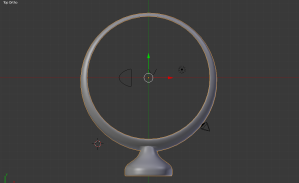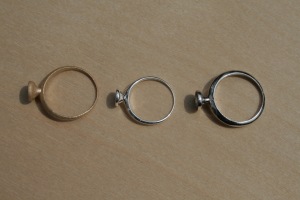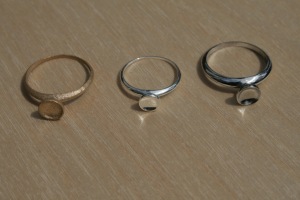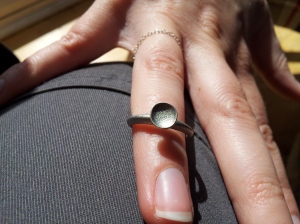For about 5 years I have been making jewellery on and off in my spare time. In all that time I have been using sterling silver. There are a number of reasons for this but the main one is price. At about 50p a gram you can afford to screw up and call it learning. At £25 a gram gold makes mistakes much more expensive. I would like to work in “The proper precious metals” but this has always been out of my financial comfort zone.
Until Now…
Thanks to the wonders of 3D printing you can now have anything made in anything pretty much. Most interesting for me is the possibility of 3D printed metal jewellery. There are two main technologies to do this. Print a wax part and do the lost wax thing or laser sintering which builds up the part from powder. Neither technology has really come out on top yet as an all out winner though. A bit like inkjet vs. laser, each has advantages and disadvantages,
So to try out this new technology I devised a fair and representative test. Send the same design off to 3 manufactures and see what comes back.
That’s not quite what happened.
First I drew a ring. This ring contained fine >mm areas and larger bulk areas. It had both convex and concave surfaces that curve in 2 directions and it had square internal and external corners. The ring shank was a relatively low polygon count and the knoble was a high polygon count.
It was drawn in blender and then exported as an STL.
So off it went to the people at i.materialise to be made in silver by the lost wax method and then to be delivered to be all shiny.
i.materialise.com only do silver and gold and nothing inbetween.so i wanted more options and the next company I tried was nextDayWax. However they claimed that the shank was too thin to sprue onto so I needed to redraw it. At this point I noticed a slight mistake in my previous drawing. I had intended then to fit my wife’s finger so that I could see them “on the hand” when they arrived and I had drawn the first ring 3 sizes too small. So I redrew the ring with the shank thicker and the ring the correct size.
I had this one cast in palladium and asked for it to be unhallmarked so that I could get it hallmarked with my sponsors mark but this message didn’t get to GoldMark, the company NextDayWax use to do their casting. As it was a test piece it wasn’t too much of a problem but a bit annoying
Finally I had the orignal design (scaled to make it the correct size) produced by cooksongold emanufacturing which is a laser sintering process and cooksons only do in 18K gold. Unusually for a 3D printing company cookson have quite steep sliding scale for production cost with one unit costing £203.90 +metal to £64.77+metal each if buy 20 or more. They did gave me a “try your concept price of £61.16+metal since it was my fist order which I thought was nice of them. They are definitely the least slick in their web purchasing system though as you have to use WeTransfer to send the file which they then evaluate and send you a quote for which you then have to accept and if you don’t have a cookson gold account they then have to set that up, then when it’s made they send you a pro forma and you have to phone up to pay.
So now I have 3 sightly different rings in different metals to compare.
| material | finish | cost | timeframe | ||||
| service | metal | total | delivery | ||||
| I.materialise.com | Sterling silver | polished | 26.99 | 7.69 | 3 weeks 1day | ||
| nextdaywax | Palladium | process | 25 | 60.68 | 111.22 | 7 | 5 days(once design sorted) |
| cookson | 18k Gold | process | 61.16 | 41.68 | 102.84 | 7.74 | 3 weeks 3 days |
from left to right, gold, silver, palladium
The palladium one I polished myself with abrasive silicone wheels and points. when it arrived it looked like this:





